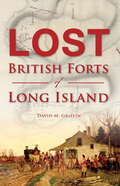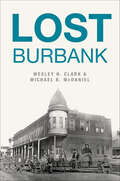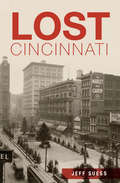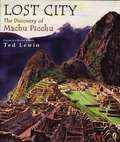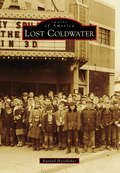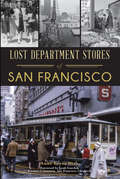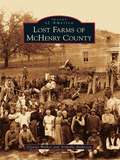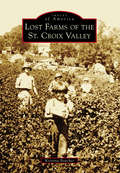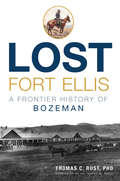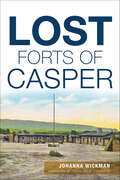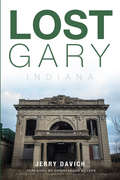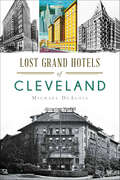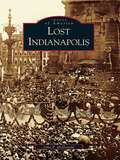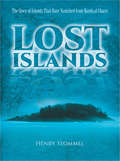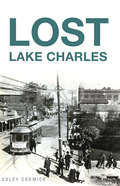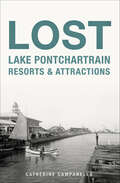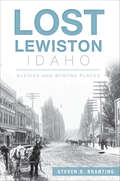- Table View
- List View
Lost British Forts of Long Island (Lost Ser.)
by David M GriffinAuthor David M. Griffin uncovers the lost history and harrowing stories of Long Island's British forts.When the Revolutionary War broke out and New York City had fallen in 1776, the forces of the king of Great Britain developed a network of forts along the length of Long Island to defend the New York area and create a front to Patriot forces across the Sound in Connecticut. Fort Franklin on Lloyd's Neck became a refugee camp for Loyalists and saw frequent rebel attacks. In Huntington, a sacred burial ground was desecrated, and Fort Golgotha was erected in its place, using tombstones as baking hearths. In Setauket along the northern shore, the Presbyterian church was commandeered and made the central fortified structure of the town.
Lost Burbank (Lost)
by Wesley H. Clark Michael B. McDanielSlowly fading with the city's ever-changing landscape, the places and people of Burbank's past tell a vibrant story. Before the arrival of Warner Bros. and Walt Disney, First National Pictures built its original studio lot on Olive Avenue in 1926. For over sixty years, Lockheed Aircraft Company produced some of the nation's best airplanes where the massive Empire Shopping Center now stands. Heavyweight champion James Jeffries turned his Burbank ranch home and barn into a beloved landmark and boxing venue. And inventor Joseph Wesley Fawkes's scheme to build a monorail to Los Angeles became a local laughingstock. Die-hard Burbankers Wes Clark and Michael McDaniel collect these and many more forgotten local stories where they can finally be found.
Lost Chester River Steamboats: From Chestertown to Baltimore (Transportation)
by Jack ShaumIn the golden age of the steamer, the rich bounty of the Eastern Shore was transported down the Chester River and across the Chesapeake Bay to the port of Baltimore. For over one hundred years, vessels like the Maryland, the Chester and the B.S. Ford traversed these winding waters laden with fruit, grains, crabs and oysters. For a dollar, passengers could enjoy the novelty of a ride and the slow panorama of the shoreline. Through freeze and fog, skilled captains plied the waterways until the last of the steamers--the Bay Belle--made its final passage in the 1950s. Author and historian Jack Shaum journeys back to the bygone days of the Chester River's steamboats.
Lost Cincinnati (Lost)
by Jeff SuessCincinnati earned its nickname of "Queen City of the West" with a wealth of fine theaters and hotels, a burgeoning brewery district and the birth of professional baseball. Though many of these treasures have vanished, they left an indelible mark on the city. Revisit the favorite locales from old Coney Island to Crosley Field. Celebrate lost gems, such as the palatial Albee Theater and the historic Burnet House, where Generals Grant and Sherman plotted the end of the Civil War. Along the way, author Jeff Suess uncovers some uniquely Cincinnati quirks from the inclines and the canal to the infamous incomplete subway. Join Suess as he delves into the mystery and legacy of Cincinnati's lost landmarks.
Lost City: The Discovery of Machu Picchu
by Ted LewinCaldecott Honor-winner Ted Lewin takes readers on a thrilling journey to the wilds of Peru in this story of Hiram Bingham, who, in 1911, carved a treacherous path through snake-filled jungles and across perilous mountains in search of Vilcapampa, the lost city of the Incas. Guided the last steps by a young Quechua boy, however, he discovered not the rumored lost city, but the ruins of Machu Picchu, a city totally unknown to the outside world, and one of the wonders of the world.
Lost Coal Country of Northeastern Pennsylvania (Images of Modern America)
by Lorena BeniquezLost Coal Country of Northeastern Pennsylvania documents the region’s disappearing anthracite history, which shaped the legacy of the United States of America and the industrial revolution. The coal mines, breakers, coal miners’ homes, and railroads have all steadily disappeared. With only one coal breaker left in the entire state, it was time to record what would soon be lost. Unfortunately, one piece of history that persists is underground fires that ravage communities like Centralia. Blazing for over 50 years, the flames of Centralia will not be doused anytime soon. Images featured in the book include the St. Nicholas coal breaker, Huber coal breaker, Steamtown National Historic Site, Lackawanna Coal Mine Tour, Eckley Miners’ Village, Centralia, and the Knox Mine disaster. A hybrid history book and travel guide, Lost Coal Country of Northeastern Pennsylvania is one final recounting of what is gone and what still remains.
Lost Coldwater
by Randall HazelbakerIn 1831, Rev. Allen Tibbits and Joseph Hanchett arrived in the area that would become Coldwater. Together, they platted out a village and named it Lyons after their hometown in New York. Potawatomi Indians called the area "chuck-sey-ya-bish," which translated to "cold water," and within two years the settlers followed the Indians' example in naming the village. Many pioneers traveled on the Historic Sauk Trail (now US Route 12), which connects Detroit to Chicago, putting Coldwater on the map. The introduction of the Erie Canal in 1825--and railroad transit in 1850--revolutionized travel and spawned rapid growth. By 1861, Coldwater was recognized as a city. As a result of this growth, cottages at Coldwater Lake started showing up in the late 1870s as "summer getaways," enticing tourists to the area. In addition, cultural outlets like the Tibbits Opera House, built in 1882 and boasting Second Empire architecture, graced the downtown area.
Lost Cosmonaut: Observations of an Anti-Tourist
by Daniel KalderDaniel Kalder belongs to a unique group: the anti-tourists. Sworn to uphold the mysterious tenets ofThe Shymkent Declarations, the anti-tourist seeks out the dark, lost zones of our planet, eschewing comfort, embracing hunger and hallucinations, and always traveling at the wrong time of year. In Lost Cosmonaut, Kalder visits locations that most of us don't even know exist -- Tatarstan, Kalmykia, Mari El, and Udmurtia. He loves these places because no one else does, because everyone else passes them by. A tale of adventure, conversation, boredom, and observation -- occasionally enhanced by an overactive imagination -- Kalder reveals a world of hidden cities, lost rites, mail-order brides, machine guns, mutants, and cold, cold emptiness. In the desert wastelands of Kalmykia, he stumbles upon New Vasyuki, the only city in the world dedicated to chess. In Mari El, home to Europe's last pagan nation, he meets the chief Druid and participates in an ancient rite; while in the bleak industrial badlands of Udmurtia, Kalder searches for Mikhail Kalashnikov, inventor of the AK-47, and inadvertently becomes a TV star. An unorthodox mix of extraordinary stories woven together with fascinating history, peculiar places, and even stranger people,Lost Cosmonautis poetic and profane, hilarious and yet oddly heartwarming, bizarre and even educational. In short, it's the perfect guide to the most alien planet in our cosmos: Earth.
Lost Council Bluffs (Lost)
by S. M. SendenNestled in the Loess Hills, Council Bluffs grew from a frontier settlement of wickiups and log cabins. The outpost boomed as a gateway to the West when gold was discovered in California in 1849. The Pacific House and the Ogden House became landmark hotels for the transient population. Meanwhile, residents thrived and cultivated a bustling city with the Masonic Hall, Dohany's Opera House and the Merriam block. None of these once iconic buildings remains today. Author S.M. Senden explores the perpetual rebirth of Council Bluffs through its most important buildings and relates a still unfolding story.
Lost Dearborn (Lost)
by Craig E. HutchisonThroughout its existence, Dearborn has been a pioneer settlement, a multicultural hub, a college town, a major tourism center and a world-renowned industrial city. Unfortunately, due to a variety of factors, significant structures have been lost to time. Almost all of the eleven U.S. Arsenal complex buildings have disappeared since the arsenal was closed in 1875. The hallways of the Edison School and Oxford School still live on in the hearts of their students but were razed long ago. Even beloved edifices such as the Ford Rotunda and the Ford Motor Company Administration building, built by Dearborn's favorite son, Henry Ford, are now only a memory. Author Craig E. Hutchison endeavors to immortalize the important foundational building blocks of an evolving city.
Lost Department Stores of San Francisco (Landmarks)
by Anne Evers HitzIn the late nineteenth century, San Francisco's merchant princes built grand stores for a booming city, each with its own niche. For the eager clientele, a trip downtown meant dressing up--hats, gloves and stockings required--and going to Blum's for Coffee Crunch cake or Townsend's for creamed spinach. The I. Magnin empire catered to a selective upper-class clientele, while middle-class shoppers loved the Emporium department store with its Bargain Basement and Santa for the kids. Gump's defined good taste, the City of Paris satisfied desires for anything French and edgy, youth-oriented Joseph Magnin ensnared the younger shoppers with the latest trends. Join author Anne Evers Hitz as she looks back at the colorful personalities that created six major stores and defined shopping in San Francisco.
Lost Elkmont (Images of America)
by Daniel L. PaulinPrior to the formation of the Great Smoky Mountains National Park (GSMNP) in 1934, the small community of Elkmont was established as a logging camp by Col. Wilson B. Townsend's Little River Lumber Company around 1908. This was after he purchased 86,000 acres of mostly virgin forest. The area that was previously inhabited by various American Indian groups, and later by European-American settlers beginning around 1830, was to become for a time the second largest town in Sevier County, Tennessee. Colonel Townsend's business ventures proved successful beyond expectation, as he skillfully exploited the area's valuable hardwood forests. His logging company and railroad provided a mountain population with jobs and steady wages. Once all the valuable timber was harvested, Townsend sold land to private citizens who established what was to become an exclusive summer community that included both the Appalachian and Wonderland Clubs. These coexisted inside the GSMNP until 1992. This is the story of Elkmont.
Lost Farms of McHenry County
by Arabella Anderson Glynnis WalkerFarmers from the East found the broad and fertile prairies of McHenry County offered the perfect soil and climate for growing corn, wheat, oats, barley, and rye. This led the way for a flourishing dairy industry that eventually supplied milk to the city of Chicago. The first settlements appeared in 1835 in towns such as Crystal Lake, Woodstock, Harvard, and Cary. Families such as the Walkups, the Crandalls, the Beardsleys, the Stickneys, and the Terwilligers travelled by oxcart and rode on horseback from distant states. As word of the lush countryside spread, other farmers came from England, Ireland, and Germany to plow the fertile fields of the nation's heartland.
Lost Farms of the St. Croix Valley (Images of America)
by Kristina BoucherThe St. Croix Valley has been a haven for farmers since the first boom in the 1850s. The St. Croix River was a mecca for early industry, and the vast Minnesota and Wisconsin prairies have provided the natural resources for the region’s farmers to grow their crops and their families. The valley was dotted with brightly painted barns, a sign of economic success. However, as time wore on, the St. Croix Valley experienced an agricultural downturn. Barns have been left abandoned. Fields have been turned into subdivisions. An era has passed, and the barns and farms that were once proud reminders of the region’s success are disappearing from the countryside. But why? Lost Farms of the St. Croix Valley explores the history of the region, shares the photographs and stories of local farmers, and evaluates why the traditional family farm is falling by the wayside.
Lost Fort Ellis: A Frontier History of Bozeman (Lost)
by Thomas C. Rust Dr Harry FritzEstablished in 1867 in the Gallatin Valley of Montana, Fort Ellis played a key role in the development of the Montana frontier. From post commanders attacking the town to restoring order when riotous mobs got out of control, explore the ambivalent, albeit contentious, relationship from 1867 to 1886 between the civilians and soldiers in whimsical but dramatic fashion. Competing visions of economic and military conditions on the frontier led to a complex relationship that has all the drama of a Hollywood western. Join MSU-Billings history professor Dr. Thomas C. Rust as he examines the fort's impact on the social and economic development of early Bozeman, the problems of military command and the dynamics of the soldier-civilian interaction on Montana's frontier.
Lost Fort Worth (Lost)
by Mike NicholsFrom the humble beginnings of a frontier army camp, Fort Worth transformed into a city as cattle drives, railroads, oil and national defense drove its economy. During the tremendous growth, the landscape and cultural imprint of the city changed drastically, and much of Cowtown was lost to history. Witness the birth of western swing music and the death of a cloud dancer. See mansions of the well-heeled and saloons of the well-armed. Meet two gunfighters, one flamboyant preacher, one serial killer and one very short subway carrying passengers back in time to discover more of Fort Worth. Author Mike Nichols presents a colorful history tour from the North Side to the South Side's Battle of Buttermilk Junction.
Lost Forts of Casper (Lost)
by Johanna WickmanThree army outposts built before and during the Civil War protected critical routes along the western trails at the North Platte River near what later became Casper. All had been abandoned by 1867, and their dramatic stories are mostly forgotten. The Post at Platte Bridge was a vital outpost on Albert Sidney Johnston's Utah War supply route. Camp Dodge and Platte Bridge Station, also called Fort Caspar, guarded telegraph lines from Native American sabotage. Violent winds, horrendous blizzards and scorching summers made life miserable. Tension reached a fever pitch at the Battle of Platte Bridge when Sioux, Cheyenne and Arapaho attacked a cavalry detachment led by Caspar Collins. Today, a reconstructed Fort Caspar stands as a vigilant reminder of the struggles at those lonely frontier stations. Local historian Johanna Wickman chronicles military efforts to keep the peace, wage war and merely survive.
Lost Gary, Indiana (Lost)
by Jerry DavichA poster child for our nation's urban experimentation a century ago, Gary was forged with hype and hope, dreams and sweat, political agendas and tons of steel. The hardscrabble city attracted all kinds, from shady scoundrels and famous architects to hardworking immigrants and brilliant entrepreneurs. Boasting 180,000 residents at its peak, the booming melting pot eventually faded away under the afflictions of urban decay, racial unrest and political upheaval. Jerry Davich explores the remnants of Gary's glory days, from Union Station in ruins to City Methodist Church stripped of its soul. Revisit the Sheraton Hotel's demise, Emerson High School's hard lessons, Vee-Jay Records' last release and a devastated downtown filled only with façades and fond memories.
Lost Grand Hotels of Cleveland (Landmarks)
by Michael DeAloiaDuring Cleveland's heyday, the world's most influential businessmen, politicians and entertainers flocked to America's sixth-largest city, enjoying the full hospitality of splendid hotels befitting a first-rate metropolis. Marked by architectural splendor, sumptuous design, technical innovation and world-class service, these grand palaces rose and fell with Cleveland's fortunes. From Teddy Roosevelt dining under the ornate chandeliers of the Hotel Hollenden's famed Crystal Ballroom to Bob Hope and Jack Benny cracking wise at the Alcazar's bar, Michael DeAloia adds atmosphere to seven of the most elegant and inviting Cleveland hotels to emerge in the early twentieth century. Only one of these legendary establishments hosts guests today. This revealing chronicle recaptures the golden age of Cleveland's power and prestige.
Lost Indianapolis
by John P. McdonaldIn 1816, the U.S. Congress decided to give the newly formed State of Indiana four square miles of land to lay out a capital city. Just where the capital city would be platted, however, was unknown. Four years later, the spot was finally chosen near where Fall Creek meets the White River. From that moment forward, despite a few bumps along the way, Indianapolis began its development into one of the nation's great cities. Over the course of that development, many buildings, companies, legends, and people have come and gone. While they are now only shadows of the past, they help to form the history and heart of Indianapolis.
Lost Islands: The Story of Islands That Have Vanished from Nautical Charts
by Henry StommelHundreds of islands that once appeared on nautical charts and general atlases are now known to have vanished — or never even existed. How were they detected in the first place? Henry Stommel, an oceanographer and senior scientist at Massachusetts' Woods Hole Oceanographic Institute, chronicles his fascinating research in documenting the false discoveries of these phantom islands.British and American Hydrographic Offices compiled lists for navigators of reported dangers corresponding to the islands' supposed locations, which formed the basis for Stommel's surveys. These tales, which unfold according to location, blend historical and geographic background with intriguing anecdotal material. They relate how the small land formations came to be charted, who reported them, who eradicated them, and why some of them endured for so long. The chronicle of navigational errors, optical illusions, wishful thinking, and other mishaps is illustrated by scores of black-and-white images, including two 19th-century Admiralty charts of the Indian and Pacific Oceans, where most of the sightings took place.
Lost Japan
by Alex KerrDrawing on the author's personal experiences of Japan over a period of over 30 years, this book takes its readers on a backstage tour, exploring different facets of the author's involvement with the country. The Japanese edition of this book was awarded the 1994 Shincho Gakugei Literature Prize.
Lost Lake Charles (Lost)
by Adley CormierFires, hurricanes, neglect and progress erased much of Lake Charles’s physical history. The young town was a magnet for pirates and privateers, like the infamous Jean Lafitte, who conducted business at the mouth of what is today called the Contraband Bayou. Michigan Men, creoles and cowboys made their way to the fledgling Louisiana town to start new lives. A great lumber industry shaped the town in the nineteenth century. Streetcars ran routes around the clock seven days a week. Author and historian Adley Cormier delves deep into Lake Charles’s past to uncover a history that has been lost to time and change.
Lost Lake Pontchartrain Resorts & Attractions (Lost)
by Catherine CampanellaPleasure seekers have visited Lake Pontchartrain destinations for more than two centuries. From grand resorts like the Pontchartrain Hotel to simple camps at Little Woods, these shores welcomed visitors by steamboat and train to dance, dine, drink and gamble. Milneburg was home to a noted hotel and bathhouses, while Mandeville was a popular spot to escape the heat. Entertainment included the contortionist "Happy Frog" Holman, the Great Wallendas and Armand Piron's Jazz Orchestra. Join author Catherine Campanella for a fascinating look back at the camps, restaurants and amusement parks lost to nature, neglect and changing times.
Lost Lewiston, Idaho: Elegies and Bygone Places (Lost)
by Steven D. BrantingLewiston has a proud heritage of historic preservation. Yet, as with other communities, it has neglected and thrown away once-treasured landmarks and precious memories with the passage of time. Some legacies were crafted with brick and mortar, others with flesh and blood. Nothing is permanent unless we make it so. Join award-winning historian Steven D. Branting as he takes a focused look at some of Lewiston's bygone edifices and the ambitious civic leaders and craftsmen who fashioned them. Reconnect with the city's scholars, its pious, its dreamers and one desperate teenager. They all made Lewiston what it once was, bequeathed their present to be our past and have sadly faded from our view.
